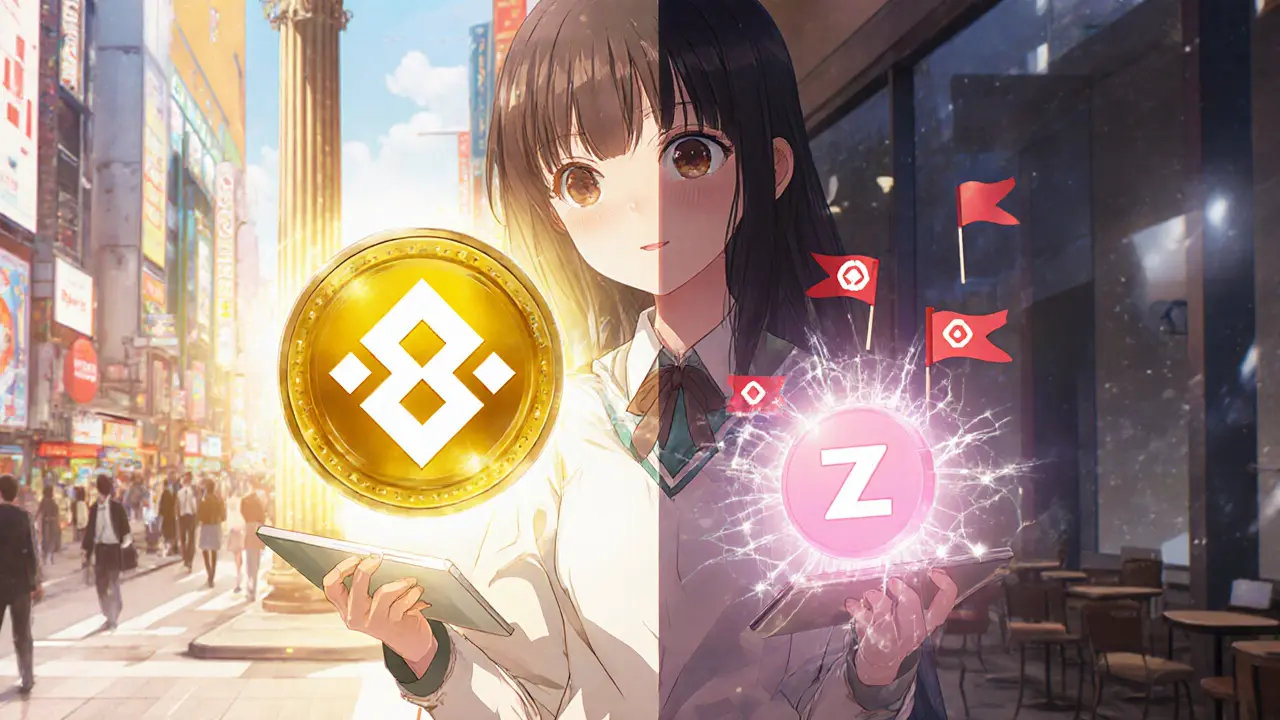ZedDex Exchange Review: Zero‑Fee Crypto Platform Examined

ZedDex vs. Major Exchanges Comparison Tool
- Launch Year: 2024
- Supported Coins: 4
- Trading Pairs: 6
- Fees: 0.00% maker/taker
- Daily Volume: ~$5,000
- Liquidity: Low (~few hundred USD)
- Regulation: Unregulated
- Security: None documented
- Launch Year: 2017
- Supported Coins: 1,500+
- Trading Pairs: 2,000+
- Fees: 0.02% maker / 0.10% taker (standard)
- Daily Volume: ~$30B
- Liquidity: High (millions USD)
- Regulation: Licensed in multiple jurisdictions
- Security: Cold storage, insurance fund, proof-of-reserves
Key Takeaway
While ZedDex advertises zero fees, it lacks critical features like high liquidity, security measures, and regulatory compliance. Binance offers comprehensive features but charges standard fees.
Trade Simulation
Estimate the impact of fees and liquidity on your trading experience:
Trade Impact Analysis
When you see a crypto platform bragging about zero fees, the first question is always - what’s the catch? ZedDex Exchange is a cryptocurrency exchange built on Binance Smart Chain that launched in 2024. It markets itself as a no‑fee venue with a handful of trading pairs. In practice, however, the exchange lives on the very fringe of the crypto ecosystem. This review breaks down everything you need to know - from fee claims and liquidity to security, regulation and real‑world usability - so you can decide whether ZedDex is a curiosity worth a quick test trade or a dead‑end that should stay off your radar.
Key Takeaways
- ZedDex lists only four coins and six trading pairs, giving it minimal market depth.
- It advertises 0.00% maker and taker fees, but the trade‑off is extremely low liquidity and virtually no user base.
- No regulatory licenses, cold‑storage, proof‑of‑reserves or insurance funds are documented.
- Average monthly traffic sits at 47 visitors - less than the staff of a small café.
- For most traders, established platforms like Binance or Coinbase provide far better security, liquidity and support.
What ZedDex Actually Offers
The exchange runs on Binance Smart Chain, which means transaction fees are paid in BNB and the network’s fast block times are inherited. ZedDex’s public roadmap is essentially non‑existent; the site (zedDEX.com) only shows a simple login box, a list of supported assets, and a banner that reads “Zero‑Fee Trading - No Hidden Costs”.
- Supported assets: Four cryptos - typically a stablecoin, a BSC‑based utility token, and two low‑cap altcoins.
- Trading pairs: Six combos, all against BNB or the stablecoin.
- Fees: 0.00% maker and taker, as advertised. There is no clear information about withdrawal fees or network gas costs.
- Features: Spot trading only - no margin, futures, staking, or lending.
Because the exchange does not provide an API, mobile app, or even a detailed FAQ, the user experience is essentially a bare‑bones web form that asks you to paste a wallet address and hit “Trade”.
Liquidity and Trading Volume - The Hard Numbers
Liquidity is the lifeblood of any exchange. CoinGecko reports an average bid‑ask spread of 0.603% for ZedDex, which looks respectable on paper. The catch? The spread is calculated on a trading volume that sits in the 67th percentile of a pool that only includes micro‑cap platforms. In real terms, the order book depth rarely exceeds a few hundred dollars per side.
FxVerify’s traffic analysis shows just 47 unique visits per month, a 36% bounce rate, and an average session time of zero seconds. To put that into perspective, a popular exchange like Binance handles millions of daily users. ZedDex’s rank of 498 out of 614 exchanges on traffic volume underscores how little actual trading activity occurs.

Security & Regulatory Landscape
Security can’t be an afterthought. Top exchanges store 95% of assets in cold storage, publish proof‑of‑reserves, and maintain insurance funds for exchange‑related losses. ZedDex offers none of these safeguards. No audit reports, no third‑party custody, and no mention of compliance with standards such as the NYDFS BitLicense or the FCA registration.
Regulatory oversight is effectively zero. FxVerify’s regulatory assessment confirms that ZedDex operates without any government‑issued license. For users in jurisdictions that require exchanges to be registered (e.g., the U.S., UK, Australia), trading on ZedDex could expose you to legal risk.
Comparison: ZedDex vs. a Major Exchange (Binance)
| Feature | ZedDex Exchange | Binance |
|---|---|---|
| Launch Year | 2024 | 2017 |
| Supported Coins | 4 | 1,500+ |
| Trading Pairs | 6 | 2,000+ |
| Maker / Taker Fees | 0.00% / 0.00% | 0.02% / 0.10% (standard tier) |
| Average Daily Volume (USD) | ≈ $5,000 | ≈ $30B |
| Liquidity (order‑book depth) | Low - few hundred dollars per side | High - millions per side |
| Regulatory Status | Unregulated | Licensed in multiple jurisdictions (e.g., Malta, Singapore) |
| Security Measures | None documented | Cold storage, insurance fund, proof‑of‑reserves |
The table makes it clear: ZedDex’s zero‑fee claim is offset by a lack of assets, depth, and safety nets that most traders rely on. If you need to move a few dollars quickly and don’t care about execution price, ZedDex might work. For anything beyond that, the trade‑off is too steep.
Who Might Actually Use ZedDex?
Given the data, the exchange fits only a narrow set of use cases:
- Testing wallet connectivity. Developers looking for a simple BSC‑based spot market to practice API‑free trades.
- Micro‑transactions. Users who want to move tiny amounts (under $10) without paying fee‑related overhead.
- Exploratory research. Enthusiasts comparing zero‑fee models, even if the platform is effectively a sandbox.
Even in these scenarios, the absence of community support means you’re on your own if something breaks.

Red Flags & Common Pitfalls
- No user reviews. FxVerify shows a 0/5 rating and zero testimonials - a strong indicator of low adoption.
- Thin order books. Slippage can explode on even modest trades.
- Lack of documentation. No API, no help center, no KYC/AML policy visible.
- Regulatory vacuum. Potential for account freezes or legal scrutiny in regulated markets.
- Potential exit scam. With such low traffic, the platform could disappear overnight without notice.
How to Get Started (If You Still Want To)
- Visit zedDEX.com and click “Register”. No email verification is required, but you should create a strong password.
- Connect a BSC‑compatible wallet (MetaMask, Trust Wallet). The site only accepts direct address input - there’s no OAuth login.
- Deposit BNB to cover network gas. Remember, the exchange itself does not charge a trading fee, but you still pay BNB gas on the Binance Smart Chain.
- Choose one of the six available pairs, enter the amount, and confirm the transaction.
- Monitor the transaction on BscScan - you’ll see the raw contract call because ZedDex does not provide a custom order‑book UI.
Because there’s no customer support hotline, any issue will need to be resolved by checking the blockchain explorer and, if necessary, contacting your wallet provider.
Future Outlook & Verdict
Since its launch, ZedDex has shown no signs of growth. Monthly traffic remains single‑digit tens, and no new asset listings have been announced for more than a year. Industry analysts predict that unregulated, low‑liquidity platforms face a high failure rate - roughly 38% shut down within two years, according to the Cambridge Centre for Alternative Finance (2024).
Unless the team secures regulatory licenses, builds a robust liquidity pool, and adds essential security features, ZedDex is likely to fade into obscurity or become a target for a buy‑out by a larger player looking for a cheap BSC foothold.
Bottom line: Zero fees sound appealing, but without liquidity, security, and compliance, ZedDex is a niche tool for testing, not a trustworthy venue for real trading.
Frequently Asked Questions
Is ZedDex regulated in any jurisdiction?
No. FxVerify’s assessment confirms that ZedDex operates without any government‑issued license or registration. Users should treat the platform as unregulated.
What are the actual fees when trading on ZedDex?
ZedDex advertises 0.00% maker and taker fees. However, you still pay BNB network gas for each transaction, which can range from $0.10 to $1.00 depending on network congestion.
Can I withdraw my funds instantly?
Withdrawals are processed on‑chain, so you need to wait for BSC block confirmations (typically a few seconds). There is no internal withdrawal queue, but the platform does not provide a status dashboard.
How does liquidity on ZedDex compare to major exchanges?
Liquidity is extremely thin - the order‑book depth often stays under a few hundred dollars per side. By contrast, Binance regularly shows millions of dollars in depth for the same pairs.
Is ZedDex safe for large trades?
No. The platform lacks cold storage, insurance, and audits. Large orders would likely cause severe slippage, and there is no recourse if funds are lost.







Ayanda Ndoni
October 10, 2025 AT 16:29Zero fees? Cool. I tried it once. My trade took 12 hours to confirm and I lost $3 in gas anyway. Now I just use Binance and call it a day. Why stress?
Serena Dean
October 10, 2025 AT 16:51Honestly, this is the most accurate breakdown I’ve read. ZedDex is like a pop-up lemonade stand at a highway rest stop - cute, but you’re not gonna get your money’s worth. If you’re testing wallet connections, sure. Anything else? Stick with the big boys.
James Young
October 11, 2025 AT 16:10Anyone who still thinks zero fees = good is either new or delusional. Gas is still there. Slippage is worse than a bad date. And no insurance? You’re basically betting your crypto on a dice roll. This isn’t innovation - it’s negligence wrapped in marketing fluff.
Chloe Jobson
October 11, 2025 AT 23:56Low liquidity + no audits = high risk profile. Even if the UI is clean, the underlying infrastructure is a black box. For DeFi newbies, this is a trap disguised as a gift.
Jonathan Tanguay
October 12, 2025 AT 19:27Look I’ve been in this game since 2015 and I’ve seen a hundred of these zero-fee scams. They all start with a slick landing page and a promise. Then they vanish. Or worse - they get hacked and everyone’s funds get swept into some Russian wallet farm. ZedDex? It’s not even on the radar. 47 visitors a month? That’s less than my cat’s Instagram followers. And you wanna trade here? Bro. You really wanna trade here?
Akinyemi Akindele Winner
October 13, 2025 AT 05:02Man, this platform is like that uncle who says he invented a time machine but only uses it to find his lost socks. Zero fees? Yeah right. You pay in patience, stress, and the occasional panic attack when your trade hangs forever. I love it. Keep it weird.
MANGESH NEEL
October 14, 2025 AT 03:19You people act like this is some kind of moral failure. Newsflash: crypto is a wild west. If you’re too scared to trade on a site with 47 users, you shouldn’t be in crypto at all. This is freedom. No gatekeepers. No corporate overlords. Just you, your wallet, and the blockchain. If you lose money? That’s the price of liberty.
Ali Korkor
October 14, 2025 AT 22:17If you’re just dipping your toes in, ZedDex could be a fun sandbox. Just don’t put more than $20 in it. Use it to learn how to connect your wallet, see what a raw transaction looks like, then go use Binance like a grown-up. Baby steps.
madhu belavadi
October 15, 2025 AT 04:18Why do people keep falling for this? They see ‘zero fee’ and their brain shuts off. It’s like seeing a free lunch and not asking who made it or if it’s poisoned. Sad.
Dick Lane
October 15, 2025 AT 06:31I’ve used ZedDex twice. First time, my trade went through fine. Second time, my BNB gas fee doubled and the trade never showed up. I checked BscScan - it was stuck. No support. No reply. Just silence. I lost $8. Worth it for the lesson I guess.
Norman Woo
October 15, 2025 AT 18:17What if this is a honeypot? What if they’re collecting wallet addresses to target for phishing? What if the whole thing is just a front to harvest private keys? I’m not saying it is… but I’m also not sleeping tonight
Andrew Morgan
October 15, 2025 AT 18:32Zero fees sounds like magic until you realize the magic is just you paying in anxiety and lost time. I tried it. My transaction took 17 minutes. I was sweating like I was in a casino. Then I switched to Coinbase and did the same trade in 4 seconds. The difference? Peace of mind. You can’t put a price on that.
Michael Folorunsho
October 15, 2025 AT 19:09Why would any American trust a platform with no regulatory oversight? This isn’t some libertarian utopia - it’s a liability waiting to happen. If you’re not in the U.S., fine. But if you’re here? You’re asking for trouble. The SEC will come for you too, even if the exchange is offshore.
Roxanne Maxwell
October 15, 2025 AT 20:38I think it’s sweet that someone tried to build something small and simple. Maybe they’re just one person with a dream. But dreams need structure. And structure needs safety. This feels like a sketch on a napkin. Cute. But not ready for dinner.
John Murphy
October 16, 2025 AT 04:36Anyone else notice how the site doesn’t even have a privacy policy? That’s not just lazy - that’s legally sketchy. If they don’t care enough to write one, why would you trust them with your assets?
Zach Crandall
October 16, 2025 AT 22:20As a Canadian, I find it alarming that this platform operates without any compliance infrastructure. Our regulators are strict for a reason. If you’re trading on ZedDex and you’re in a jurisdiction that requires KYC, you’re already in violation. This isn’t rebellion - it’s recklessness.
Patrick De Leon
October 17, 2025 AT 12:36Zero fees? Sure. But what about the cost of your time? Your peace? Your security? You’re not saving money - you’re outsourcing risk to yourself. And that’s the most expensive trade of all.
olufunmi ajibade
October 18, 2025 AT 06:45I run a small crypto education group in Lagos. We told our members to avoid ZedDex. One guy ignored us. Lost his entire $500 stash. Now he’s crying on Twitter. We told him. But he wanted ‘free’. Sometimes free is the most expensive thing.
Elliott Algarin
October 18, 2025 AT 19:44It’s funny how we romanticize the underdog. But in crypto, the underdog is usually just the one who didn’t survive. ZedDex isn’t a revolution - it’s a footnote. And footnotes don’t pay your bills.
Elliott Algarin
October 19, 2025 AT 09:52There’s something poetic about a platform that’s so small it doesn’t even have a support team. Like a lighthouse with no light. Still standing. Still visible. But useless when you need it most.